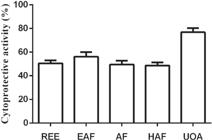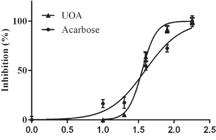ABSTRACT
Mansoa hirsuta (Bignoniaceae) is a native plant from caatinga in Brazilian semiarid. This plant has been locally used as antimicrobial and hypoglycemiant agents, but their action mechanisms and toxicity remain largely unknown. Therefore, we evaluated the composition and antioxidant, cytoprotective and hypoglycemiant effects of raw extract, fractions and compounds from leaves of M. hirsuta. The cytogenotoxic effects of ursolic and oleanolic acids, the main phytotherapic components of this plant, were assessed. The raw extract and fractions presented steroids, saponins, flavonols, flavanonols, flavanones, xanthones, phenols, tannins, anthocyanins, anthocyanidins and flavonoids. The ethyl acetate fraction inhibited efficiently the cascade of lipid peroxidation while the hydroalcoholic fraction was richer in total phenols and more efficient in capturing 2,2-diphenyl-1-picrylhydrazyl (·DPPH) and 2,2'-azino-bis (3-ethylbenzthiazoline-6-sulfonic acid) (ABTS·+) radicals. The isolated fraction of M. hirsuta also inhibited the α-amylase activity. Cytotoxic effects were absent in both raw extract and fractions while ursolic+oleanolic acids were efficient in protecting cells after exposure to hydrogen peroxide. Moreover, this mixture of acid shad no significant interference on the mitotic index and frequency of nuclear and/or chromosomal abnormalities in Allium cepa test. Therefore, M. hirsuta represents a potential source of phytochemicals against inflammatory and oxidative pathologies, including diabetes.
Key words:
antioxidant; caatinga; cytotoxicity; hypoglycemiant; phytochemistry.

 Thumbnail
Thumbnail
 Thumbnail
Thumbnail
 Thumbnail
Thumbnail
 Thumbnail
Thumbnail
 Thumbnail
Thumbnail
 Thumbnail
Thumbnail





